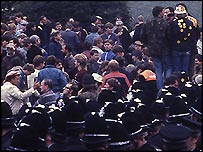|
John Henry
BBC News, Yorkshire
|


Miners were locked in a bitter struggle with the Coal Board
|
Twenty-five years ago the then most powerful union in the UK called a strike which was to prove the biggest battle between government and a workforce for decades. It would be a year before the miners returned to work following a bitter, violent dispute. The Miners' Strike started when the National Coal Board announced on 5 March, 1984, the closure of Cortonwood pit near Barnsley in South Yorkshire. Days later, miners' unions were told of a wide-ranging pit closure programme. By 12 March, Scottish miners had joined the action and half of Britain's 187,000 pitmen had downed tools. Strike roots The roots of the strike were deeper than the initial dispute between the National Coal Board and the National Union of Mineworkers (NUM) in the spring of 1984. A decade earlier, a coal strike had helped to bring down Ted Heath's Conservative government and, by 1984 and just five years into her premiership, Margaret Thatcher was determined she would not suffer the same fate. But a nationalised coal industry which needed large subsidies was at odds with the Thatcher government's vision for economic change.

Pickets and police clashed at the Orgreave coking plant
|
Knowing a confrontation with the powerful and hostile NUM would eventually come, Margaret Thatcher appointed Ian McGregor as head of the Coal Board. Coal was stockpiled at power stations so any action would have to go on for months before the country's energy supply could be held to ransom. Not only had the government been prepared for action, the NUM, under the leadership of firebrand Arthur Scargill, was ready to stand its ground.
HAVE YOUR SAY
Union leaders are just as bad as politicians, they use people for their own agenda rather than the greater good.
Bob, Glasgow
Violent confrontation Three years earlier, in 1981, the Yorkshire NUM held a ballot in which its 66,000 members voted for strike action if any pit was threatened with closure "unless on grounds of exhaustion". But the strike took hold without a national ballot ever being held, an issue which caused divisions in mining communities. Flying pickets were sent to collieries around the country to persuade men to stay away from work, and although the situation had not by then turned violent, vast numbers of police were drafted in from across the country to control the situation. The most violent confrontation between the police and pickets was at the Orgreave coking plant in South Yorkshire in June 1984. When police heard that at least 5,000 miners were planning to be there on 18 June, to try to prevent coke reaching the Scunthorpe Steel works, they brought in an equal number of officers, many with riot shields. The two sides clashed with batons drawn on one side and bricks and stones used on the other, and there were injuries on both sides. Financial hardship As autumn approached the financial hardship for striking miners began to bite. Many families had to rely on soup kitchens and food parcels. When a compromise deal was put on the table Arthur Scargill refused to accept it, but a growing number of strikers were returning to work and after a tough Christmas the trickle became a flood. On 3 March, at a specially convened conference, NUM delegates voted 98 to 91 to call off the strike. Two days later many marched back to work. From 1985 onwards the pit closure programme accelerated.
|

~RS~q~RS~~RS~z~RS~20~RS~)

~RS~q~RS~~RS~z~RS~20~RS~)
Bookmark with:
What are these?